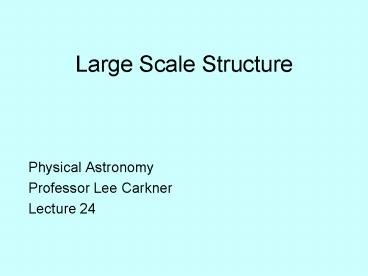Large Scale Structure PowerPoint PPT Presentation
1 / 18
Title: Large Scale Structure
1
Large Scale Structure
- Physical Astronomy
- Professor Lee Carkner
- Lecture 24
2
Distance
- The biggest issue in determining the large scale
structure of the universe is distance - First stellar parallax measurement by Bessel in
1862 - Distance methods build on each other
- Need accurate distances to near-by things to
calibrate method used for more distant things
3
Distance Methods
- Parallax uses geometry for measurement
- An object for which luminosity is related to some
observed property - Extinction is a major factor in determination
- All methods have errors
- Usually about 0.3 mag or about 10
4
Distance Ladder
- Parallax and spectroscopic parallax
- For stars in our galaxy (1 Mpc)
- Pulsating stars
- For near-by galaxies (30 Mpc)
- Globular cluster or planetary nebula luminosity
function - For intermediate galaxies (50 Mpc)
- Tully-Fisher, D-s relation
- For distant galaxies (100 Mpc)
- Type Ia supernova
- Luminosity from light curve
- For largest distances (1000 Mpc)
5
Parallax
- Shift in position of star due to viewing from
opposite ends of earths orbit - d 1/p
- Does not depend on extinction or finding
luminosity - d 10(m-M5-A)/5
- Need extinction
- Very inaccurate (M /- 1 mag)
6
Cepheids
- Pulsating stars have a relationship between
period and luminosity - Discovered by Leavitt in 1912, calibrated by
Hertzsprung in 1913 - There are multiple kinds of pulsating stars with
different P-L relationships - Can use to find absolute magnitude from P (days)
and color - MV -3.53 log Pd - 2.13 2.13(B-V)
7
Luminosity Function
- Rather than using a small sample of objects, we
can create a luminosity function - Can use with globular clusters or planetary
nebula - Calibrate so you know M for some point on the
graph and compare to the observed m
8
Galaxy Rotation
- Brighter spiral galaxies have faster rotation
- Since spiral galaxies are bright, useful out to
large distances - For elliptical galaxies we can relate the
diameter (D) to the velocity dispersion (s) - Called D-s relation
9
Type Ia Supernova
- From the lightcurve of a supernova we can find
the peak luminosity - Since M -19.3, can be used to very large
distances - Best distance and accuracy
10
Clusters
- Galaxies are grouped in clusters and
superclusters - Groups
- Size 2 Mpc
- Clusters
- Size 10 Mpc
- Superclusters
- Size 50 Mpc
11
Local Group
- Dominated by Milky Way, M31 and M33
- About 20 other small groups are within 10 Mpc
- About 80 of all galaxies are in such groups
12
Virgo Cluster
- Nearest large cluster
- Bright galaxies dominated by spirals, faint by
dwarf ellipticals
13
Intercluster Medium
- Space between galaxies in cluster is filled with
hot, ionized gas - T 108 K
- Free electrons fly past free protons and emit
braking radiation - Dominates visible mass
14
Cluster Dynamics
- Galaxies interact as they move through the
cluster - May form giant ellipticals at cluster core
15
Superclusters
- We are near the edge of the Local Supercluster
- Gravity of supercluster slows Local Group
expansion
16
Great Attractor
- All near-by galaxies are moving in the direction
of the constellation Centaurus - May be due to an unobserved supercluster called
the Great Attractor - Mass 10000 mass of Milky Way
17
Largest Scales
- Redshift surveys can be conducted to produce a 3D
map of structure - Universe consists of large voids about 100Mpc
across with galaxies clustered on the boundaries
of the voids - Voids too large for galaxies to have formed in
them and then be pulled out - Voids must be fundamental, seeded in the Big Bang
18
Next Time
- Read 27.2, 29.1, 30.1
- No Homework
- Final Exam, Monday Feb 25, 12-2pm
- 2/3 covers everything since test 2
- 1/3 covers rest of course
- 2 old 1 new equation sheet given
- 20 of grade

